July 27, 2007
Air Date: July 27, 2007
FULL SHOW
SEGMENTS
Farm Bill: Lawmakers Try to Sow Seeds of Change
/ Jeff YoungView the page for this story
Critics of farm subsidies say the billions in payments to corn, cotton and soybean growers hurt the poor and the environment. Reformers had hoped Democratic leaders in Congress would change things. But Living on Earth's Jeff Young tells us that changing agriculture politics is a tough row to hoe. (05:30)
Endangered Species Reconsidered
View the page for this story
The U.S. Fish and Wildlife Service has announced it will review eight endangered species decisions that were overseen by former Interior Department official Julie MacDonald. Host Bruce Gellerman talks to Kieran Suckling, policy director for the Center for Biological Diversity, about how MacDonald used her power to reverse scientists’ recommendations. (06:00)
Deforestation Down Under
View the page for this story
A global conference in Australia tackles the problem of deforestation and climate change. Australia’s Minister of Environment Malcolm Turnbull tells host Bruce Gellerman about why trees matter and about his country’s new initiative to use satellites to monitor the world’s forests. (05:00)
A Recreational Business
View the page for this story
Sally Jewell, president and CEO of Recreational Equipment Incorporated (REI), speaks with host Bruce Gellerman about how the co-op is trying to get kids back out into the great outdoors and reconnecting with nature. (06:15)
A Seasonal Feast
/ Ian GrayView the page for this story
Community supported agriculture programs are experiencing a boom across the country. CSA's enable individuals to buy a share of a local farm's weekly harvest. Food writer Kathy Gunst prepares a meal with fresh produce from a CSA in Cambridge, Massachusetts. (06:30)
Emerging Science Note
/ Lauren CoxView the page for this story
Lauren Cox reports on the transformative power of one species of algae. (01:30)
Trading Salt Ponds for Salt Marshes
/ Andrea KissackView the page for this story
Fertile wetlands once lined the southern shore of the San Francisco Bay. But these wetlands have since been replaced by ponds used to harvest salt. Now, a collaborative effort to bring back tens of thousands of acres of those original marshes is underway. Andrea Kissack reports. (07:00)
Home Ground: Painted Hill
/ John DanielView the page for this story
Living on Earth continues its series exploring features of the American landscape. The series is based on the book “Home Ground: Language for an American Landscape,” edited by Barry Lopez and Debra Gwartney. In this installment, Oregon writer John Daniel describes “painted hill.” (02:00)
Tea-ing off with a Master
/ Dennis FoleyView the page for this story
Master Tea Blender Giles Hilton of London's tea proprieter Whittard of Chelsea, sits down over a cup of tea to talk about--tea. (05:30)
This week's EarthEar selection
listen /
download
Sounds from the northern prairie.
Show Credits and Funders
Show Transcript
HOST: Bruce Gellerman,
GUEST: Kathy Gunst, Sally Jewell, Kieran Suckling, Malcolm Turnbull
REPORTER: Jeff Young, Andrea Kissack
SCIENCE NOTE: Lauren Cox
COMMENTARY: John Daniel
[THEME]
GELLERMAN: From Public Radio International - this is Living on Earth.
[THEME]
GELLERMAN: I’m Bruce Gellerman.
Democratic lawmakers say they’ve planted seeds of change, hoping to reap reforms in this year’s farm bill. Critics charge what they’ve sown will yield a bitter harvest.
FARBER: It’s hard to imagine that a farm bill that would allow 99.9 percent of our farmers to collect unlimited subsidies could be called reform by anyone, especially speaker Nancy Pelosi.
YOUNG: But her supporters say California Congresswoman Pelosi knows cutting subsidies will anger farmers and lose key votes.
PETERSON: She’s getting a lot of heat back in her district right now, but her sticking with us is why I think we’re gonna get this farm bill.
GELLERMAN: And we toast the traditions of tea tasting.
HILTON: There are two aspects to enjoying tea. One is in the mind and one is in the palate.
GELLERMAN: We cozy up with a teamaster.
[SLURP]
HILTON: That’s is actually super.
[SLURP]
GELLERMAN: Teatime and more this week on Living on Earth, stick around.
[MUSIC]
[NPR NEWSCAST]
ANNOUNCER: Support for Living on Earth comes from the National Science Foundation and Stonyfield Farm.
Farm Bill: Lawmakers Try to Sow Seeds of Change
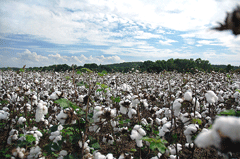
Cotton is king in Stanly County, North Carolina. (Photo: Brian Hathcock)
GELLERMAN: From the Jennifer and Ted Stanley Studios in Somerville, Massachusetts - this is Living on Earth. I’m Bruce Gellerman, sitting in for Steve Curwood. The U.S. Congress is debating a bill with huge implications for the environment. No, it’s not about climate change or endangered species it’s about farms.
Every five years the Farm Bill comes up for renewal and it affects everything from wetlands and habitat protection to alternative fuels production and international trade, not to mention the food on our tables. Critics of the current ag policy say farm subsidies negatively affect all of these things, and waste taxpayer money to boot. With Democrats in control of Congress, hopes for reform were high. But Living on Earth’s Jeff Young tells us those calling for change have a tough row to hoe.
[PEOPLE MILLING AROUND]
YOUNG: There were so many boots and cowboy hats in the house agriculture committee’s hearing room it looked like a hoedown. Lobbyists for ranchers and farmers crowded in, eager to hear what Agriculture Chairman Collin Peterson would say about the new farm bill and the billions in subsidy payments it might send to farm country. Peterson warned they might not like it.
PETERSON: Maybe what we’re doing here is just trying to come up with a bill that made everybody equally unhappy.
YOUNG: Here’s Peterson’s dilemma: Congress is under pressure to limit the massive subsidy system that pays about 20 billion dollars a year to farmers—many of whom are already quite wealthy. But about 40 percent of that money goes to the home districts of the members of the agriculture committee. So Peterson came up with a compromise: No one making more than a million dollars a year could get payments.
PETERSON: This bill represents reform. We’ve made changes that nobody thought we could never do and knock a bunch of farmers out of the system.
YOUNG: Analysis by the Agriculture department shows the new bill would eliminate only about 3100 of the one-and-a-half million subsidy recipients. Critics say that’s no reform at all.
KIND: I think the loopholes that exist with the committee bill is so large you could drive a combine through it and yet it’s not addressing the true needs of other priorities.

Cotton is king in Stanly County, North Carolina.(Photo: Brian Hathcock)
YOUNG: That’s Wisconsin Democrat Ron Kind. Kind teamed with Republican budget hawks to offer an alternative to the farm bill. They want to ban payments to farmers making more than a quarter million a year. The money saved would go instead toward programs for nutrition and land conservation. These reformers thought they’d have a good chance: crop prices are high, the U.S. faces international pressure to comply with agriculture trade agreements, even the White House wants to cut subsidies to rich farmers. A varied coalition of environmental, anti-poverty and fiscal conservative groups came together to push for change. David Keating is with the free market group, club for growth.
KEATING: I think today we see the strongest left right coalition ever assembled to work for change. And hitting congressmen from left and the right maybe we might finally score a knockout punch against the special interests.
YOUNG: It’s not often you see the Club for Growth teamed up with groups like Bread for The World. But Reverend David Beckman says his anti-hunger group finds common ground with conservatives who think that U.S. crop subsidies hurt farmers in developing countries. Beckman says cheap American grain and cotton flood global markets.
BECKMAN: Our subsidized cotton goes all over the world and it competes with cotton that’s grown in Mali, Ethiopia, Zimbabwe, South Africa. Those growers are making 400 dollars a year. But they’re up against cotton farmers in the U.S. that have all kinds of technology plus big checks from the federal government. It’s just not fair.
YOUNG: Environmentalists say subsidized crops strain the land. They wanted more money in the bill to pay farmers to protect soil, wetlands and wildlife habitat. The conservation program turns away most applicants because it’s short of cash. Scott Farber of the group Environmental Defense says Democratic leaders fell short.
FARBER: We are very disappointed that Speaker Pelosi would support a farm bill that provides less conservation spending than the proposal made by the Bush administration.
YOUNG: Farber thought he’d have California Democrat Nancy Pelosi on his side. She supported reform five years ago. But now that she’s the House Speaker, Pelosi supports the farm bill.
FARBER: It’s hard to imagine that a farm bill that would allow 99.9 percent of our farmers to get unlimited subsidies could be called reform by anyone, especially speaker Nancy Pelosi.
YOUNG: As Speaker, Pelosi needs to keep farm money flowing. She wants to protect some newly elected Democrats who represent rural, farming districts. They can’t afford to anger farmers by cutting subsidies. For example, Democrat Tim Mahoney barely won half the vote in conservative central Florida after Republican Mark Foley resigned in disgrace amid a sex scandal. Mahoney’s counting on the farm bill to bring big juicy payments to Florida fruit growers—as much as 10 million a year.
MAHONEY: We have a committee that puts farmers, and growers and ranchers first, and as a result the state of Florida was a big winner.
YOUNG: And Mahoney’s one of eight freshman Democrats on the agriculture committee. Keeping their farming districts happy could be key to keeping Nancy Pelosi in the Speaker’s chair. Agriculture Committee chair Peterson knows Pelosi is squeezed on this issue.
PETERSON: She’s getting a lot of heat back in her district, and she’s hanging in there and her sticking with us is why I think we’re gonna get this farm bill.
YOUNG: In short, farm reform ran into one of Washington’s sacred cows. The reformers lost. But they’ll try again when the Senate takes up its version of the farm bill later this year.
For Living on Earth I’m Jeff Young in Washington.
Related links:
- Environmental Working Group’s Farm Bill database
- The House Agriculture Committee website
- OXFAM on Farm Bill
Endangered Species Reconsidered

The California Red-Legged Frog. (Photo: Colin Brown
GELLERMAN: Mark Twain once quipped, “We have the best government money can buy, ” so we can well imagine what Twain would have thought about recent events at the Department of the Interior’s Fish and Wildlife Service and a frog made famous in one of Twain’s stories: “The Celebrated Jumping Frog of Calaveras County.” Last spring, Fish and Wildlife designated 450 thousand acres as critical habitat for the red-legged frog but that was nearly 40 percent less than the service’s own scientists had recommended. The Inspector General investigated, and found that Deputy Assistant Secretary of the Interior Julie MacDonald had twisted scientific evidence about the frog and other threatened species. The IG concluded MacDonald violated federal ethics rules. She leaked documents to industry lobbyists that could be used in lawsuits against the government.
Julie MacDonald resigned in May. Soon after, Lynn Scarlett, Deputy Secretary of the Interior, testified before Congress.
SCARLETT: Where there is evidence of science manipulation we will act upon it. I take that challenge and charge very seriously. You will find no greater champion of integrity in science than myself and this secretary.
GELLERMAN: Now, in what may be an unprecedented move Fish and Wildlife is going to review eight decisions that Julie MacDonald had influenced when she was working for the Department of the Interior. Kieran Suckling, Policy Director for the Center for Biological Diversity, has closely followed the endangered species cases and MacDonald's actions.
SUCKLING: Well, she would get these draft decisions to protect species or their habitat. And then she would personally go and just scratch out line by line numerous paragraphs and replace them with her own conclusions which were the exact opposite. She would find any whiff of scientific controversy and exaggerate that to say that the scientists don’t know what’s going on therefore the bureaucrats should over rule it. And she would just demand that they not reference important scientific studies at all if those studies would lead to protection of species.
GELLERMAN: Now, she wasn’t a scientist right?
SUCKLING: No, she was an engineer by training. And this is one of the things that I think infuriated the scientists so much was that in her rewriting of their text she just made a mish mash out of it, didn’t know what she was talking about and clearly just didn’t care. There was just no respect for the science at all.
GELLERMAN: Well, give me a specific example of how she might have used her influence to affect an animal that was being considered for the endangered species act.

The Gunnison Sage Grouse. (Courtesy of the California Bureau of Land Management)
SUCKLING: Well, the Gunnison Sage Grouse is a good example. This is a well-studied species. The scientists inside and outside of the agency all agreed it was very imperiled and should be put on the endangered species list. A proposal was sent up to Interior to put it on the list and MacDonald not only overruled the decision and kept it off the list, but at the same time she just ridiculed the scientists for what they were saying and just demonstrated this incredible hostility to the agency for trying to just simply do its job.
GELLERMAN: Now the Gunnison Sage Grouse isn’t one of the eight cases that’s going to be reviewed.
SUCKLING: That’s right and by our estimate there’s probably 100 endangered species decisions out there that she completely mangled that are not being reviewed either.
GELLERMAN: What could Julie MacDonald’s motive have been in keeping the Gunnison Sage Grouse off the endangered species list?
SUCKLING: Well, her motives were very clear. She was in constant contact with the livestock industry and also the oil and gas industry which is booming up in this portion of Colorado. And so she was very clearly working on their behalf to ensure that endangered species did not get in the way of them being able to trash thousands and thousands of acres of high desert habitat.
GELLERMAN: But don’t businesses have a right to legitimately express their interests to the government?
SUCKLING: Oh, absolutely. They have the right as any citizen does to participate in these public processes, submit comments, submit critiques. And if they don’t like the decision they can even file a lawsuit over it. But where MacDonald and industry crossed the line, was when they went outside the decision making process when they fudged the science and effectively lied and made a decision on political grounds instead of scientific grounds.

The California Red-Legged Frog.(Photo: Colin Brown)
SUCKLING: Mmm hmm yes.
GELLERMAN: There are 12 species of Hawaiian picture wing flies, and the southwestern willow flycatcher. Why would I care about the southwestern willow flycatcher?
SUCKLING: If you like clean water and rivers that function properly instead of flooding and destroying cities then you should like the southwestern willow flycatcher. It is a bell weather for healthy ecosystems. And by protecting it we’re protecting the water supplies that people from California to Texas require to survive. And we are protecting the foundation of life itself, and if that goes away we will certainly follow the flycatcher into extinction.
GELLERMAN: So, what happens now?
SUCKLING: Well, that’s a good question. The Administration has said they’re going to review these decisions. They, of course, were careful not to give a timeline. So I suspect that the first thing that will occur is environmentalists are actually going to sue over these decisions to make sure they actually get done. The Inspector General has opened a second investigation into MacDonald to determine whether she actually violated criminal conflict of interest laws. And so I think that we’re going to see this just grow and grow and get a glimpse of just how deep the corruption is in the Bush Administration’s Department of Interior.
GELLERMAN: Well, Kieren Suckling thank you very much.
SUCKLING: Glad to be here.
GELLERMAN: Kieran Suckling is policy director and founder of the Center for Biological Diversity.
[MUSIC: Stickmen Play “11th Hour” from ‘Polyphonic’ (Stickmen Play - 2003)]
Related link:
Center for Biological Diversity
GELLERMAN: Coming up seeing the forest for the trees on climate change. That’s just ahead on Living on Earth.
Deforestation Down Under
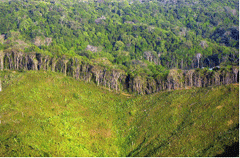
Deforestation in Panama (Courtesy of the US State Department)
GELLERMAN: It’s Living on Earth. I’m Bruce Gellerman. It’s estimated four and a half million trees, equal to about 70 thousand football fields of forest, are destroyed each day. Bad news because the world’s forests have a tremendous effect on climate change: Trees filter billions of tons of carbon dioxide from the air. Cut down the trees, we lose the filter. Burn the forests down and billions of tons of the greenhouse gas are released into the atmosphere. This past week, senior government officials from 70 countries met in Australia at the world’s first high-level meeting on forestry and climate change. At the meeting Australia’s Environment Minister Malcolm Turnbull announced a five-year, 175 million dollar initiative to use satellites to monitor the world’s forest. We reached Minister Turnbull by phone at the Sydney airport.
TURNBULL: What we’re able to do through our global initiative on forests and climate is work with other countries to incorporate our sustainable forestry into the battle against climate change. Now one of the most important things we need to do is to monitor increases and decreases in forest cover and also monitor carbon emissions. Now, we have very advanced techniques to do that in Australia and so what we want to do is to work with other countries to set up a global forest monitoring and carbon monitoring network. What that will mean is, before too long we will be able to have a very good idea of what’s happening with the world’s forest both in terms of net hectareage of coverage and also what’s happening in terms of their contribution to the carbon cycle.
GELLERMAN: But everyone knows that there’s illegal logging going on in Brazil and Indonesia, that there’s clear cutting of the forest and burning down of the forest but now what? What do you do with this information?
TURNBULL: Well, ultimately it’s up to national governments to enforce their own laws. All countries are working very hard to fight against illegal logging, but ultimately you need compliance and enforcement on the ground. Now, the kind of satellite and radar data that a network of this kind can deliver of course makes enforcement a lot easier.
GELLERMAN: Now critics say that Australia imports 400 million dollars worth of contraband timber every year. Your plan is a five-year plan for 175 million dollars. They say your plan is a drop in the bucket against these illegal imports.
TURNBULL: Well, you’re not comparing apples with apples. The 400 million dollar figure is an absolute guesstimate. And the bulk of the illegal timber imports is timber that is contained in furniture. It is hard I would say or well nigh impossible to know whether the timber that is in a chair or table that’s come from China had its origin in illegal or legally cut timber. Now we need to try to develop ways in which we can get certification right back to the source.
GELLERMAN: Well, right now there’s no incentive for loggers not to cut the forests down.
TURNBULL: This is what we’re focused on. You see what you’ve got is a market failure in that the carbon cost is not being factored into forestries. The classic case is the way the Kyoto Protocol in effect encourages deforestation. There is an incentive for countries to use biofuels such as palm oil because they’re seen as a renewable energy resource. However, to grow that palm oil you need land and often that land is being provided by rainforest that is being clear felled. Now having said that it is a weakness that is widely recognized and we are committed to addressing it in the next round of Kyoto, in Kyoto two if you like.
GELLERMAN: What’s been the United State’s reaction to your initiative and to the conference?
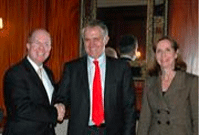
Left to right: White House Environmental Chair James Connaughton, Environment Minister for Australia Malcolm Turnbull, US Undersecretary for Democracy/Global Affairs Paula Dobriansky (Courtesy of Malcolm Turnbull)
TURNBULL: Oh, they’ve been very supportive. The U.S. was the first government - it and Indonesia - were the two first governments to support our initiative. But the important thing that we’ve achieved I think is that we’ve succeeded in lifting the profile of this issue in the climate change debate up several notches. And I don’t think there will be any difficulty in ensuring that forestry is a key part of the new climate change agenda, the post-Kyoto agenda that will begin to be framed in earnest at Bali later this year.
GELLERMAN: It seems to me surprising that it’s taken governments so long to actually address the problem of forests and greenhouse gases.
TURNBULL: Uh, yes, it’s always puzzled me. It is in many respects the least cost abatement opportunity. And of course there are so many other benefits. There are benefits to biodiversity. There are benefits to water quality. Better management of the world’s forests ticks every box.
GELLERMAN: Ok, well I know you have a plane to catch, I’ll let you go. I want to thank you very much.
TURNBULL: No, thank you.
GELLERMAN: Speaking to us on a phone in Sydney’s airport is Australia’s Environment Minister, Malcolm Turnbull.
[MUSIC: The Beta Band “The House Song” from ‘The Three E.P.s’ (Astralwerks - 1999)]
Related links:
- Malcolm Turnbull’s Website
- Global Initiative on Forests and Climate
A Recreational Business
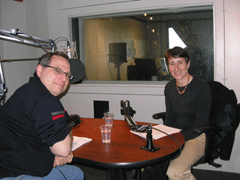
Sally Jewell, the CEO of REI with host Bruce Gellerman at the studios of Living on Earth. (Photo: Dennis Foley)
GELLERMAN: Apparently our interest in the great outdoors isn’t so great anymore. The Centers for Disease Control reports a 30 percent drop in youth participation in outdoor activities over the past decade. In fact, since 1999 recreational visits to our national parks have been on a steady downward slide. Overnight stays: down 16 percent, tent and backcountry camping have fallen nearly 20 percent. Hardest hit in terms of shear numbers of visitors are parks in the Pacific West region which is the backyard of one of the world’s largest seller of outdoor gear, REI. Recreational Equipment Incorporated is a co-op - it’s owned by its members. The 70-year-old company recently released its first annual stewardship report that aims to address the downward trend in outdoor activities. Sally Jewell is president and CEO of REI. Hi Sally.
JEWELL: It’s great to be here, thanks for having me Bruce.
GELLERMAN: The statistics are absolutely incredible. In the last decade there’s a 30 percent decline in youth participation in outdoor activities.
JEWELL: That’s true, yeah. We’ve seen a real decline especially in the use of public lands. People are getting out for activities that are closer to home and things that they might do in a day. But the activities like family camping and backpacking trips and long road trips in the car really are scaling back as people choose to do other things with their free time.
GELLERMAN: So, what’s going on? Kids are just getting to be fat and happy?
JEWELL: Kids are busier and parents are busier and I also think that technologies are becoming so good at engaging the brains of our children and perhaps ourselves that it’s much easier to stay put. Your mind is very active but your body isn’t. And what you’re seeing is increasing obesity certainly. But asthma and other diseases are increasingly problematic, and part of that is that children are getting exposed to the outdoors like they used to.

Sally Jewell, the CEO of REI with host Bruce Gellerman at the studios of Living on Earth. (Photo: Dennis Foley)
GELLERMAN: The implications of this are profound because if we are not raising kids who are used to going to the outdoors. What’s going to happen to the outdoors? Who’s going to take care of there?
JEWELL: Bingo. I think it is very difficult to expect that we’re going to have advocates for the future for the wild and scenic places or even the city parks if people haven’t been out using them and appreciating what’s there. So, if we want advocates for the future we need to be engaging children today. They are the future. And that’s also why we need to reach out across the broad spectrum of our population. Not just those families who’ve traditionally played outside and gone camping together. We need to reach out to a broader group of people that make up our population so they will advocate for these important places when they’re in the legislature or in the city councils or the mayors in the future.
GELLERMAN: Well, for you it’s even more profound because it’s really your business. That’s your customer out there.
JEWELL: I guess the good news is people aspire to do things in the outdoors. It’s still very much a part of our consciousness and part of what we need as human beings. We need nature. So part of our job as a business is to connect people back to nature, to make it easy for them. So, you don’t want to make it sound like it’s an epic journey to get into the outdoors. Part of our job is to make people feel comfortable that they can get outdoors and do things every day in the outdoors that are close to home. We have a program called PEAK, which stands for Promoting Environmental Awareness in Kids. It’s actually a backpack full of curriculum that we developed in conjunction with Leave No Trace, the environmental organization for outdoor ethics. We’ll take it out any place where kids are gathered and put on a PEAK program which gives them an introduction to the principles of outdoor ethics and connecting with nature in a low-impact way.
GELLERMAN: You have something called a gear bank. What is that?
JEWELL: In some markets across the country we put a special program of gear in place so that underprivileged groups of kids who don’t have access to quality equipment to have a good camping experience can come into REI and get outfitted so it’s packs and tents and sleeping bags and sleeping pads and stoves and in some cases clothing. We don’t want any child in the communities to not be able to equip themselves to be comfortable on a trip. We don’t want them to have a miserable experience outside. We want them to have a great experience.
GELLERMAN: You have an interesting background because you came through the corporate structure not in the you know great outdoors. You were a banker for almost 20 years. You worked for an oil company, Mobil?
JEWELL: That’s right.
GELLERMAN: Not what I would think of as your you know granola trail eating kind of a gal.
JEWELL: I started my career in oil and gas as an engineer. I would say this, that we all use hydrocarbons. And being an engineer and working for Mobil Oil I have a real understanding of the trade offs that we make when we use oil and gas. There is an impact on our planet, not only in the greenhouse gases that we produce but also in the damage to the environment that’s just inevitable when you’re going to be extracting things from the planet itself. But it’s given me a background and I think a practical way of looking at our responsibility collectively to do the right things for our planet. Reducing our consumption, taking care of our planet, trying to find ways to produce energy that aren’t so impactfull.
GELLERMAN: Is it more difficult to manage a company of the size of REI? I mean how do you make a company that’s a billion dollars in revenue a year sustainable?
JEWELL: That’s a great question. We think REI must work toward being planet neutral and of course we aren’t yet as very few companies perhaps can make the claim that they were. We think we need to set a tone not only for the outdoor industry but for other businesses in general. So, we understand now our greenhouse gas footprint, CO2 levels by every single store. We reduced that greenhouse gas from electricity by 30 percent last year by buying new renewable energy from wind and solar primarily. We are working to reduce our commuting consumption, our transportation consumption as well as recycling more. And we have goals to be planet neutral, at least from a carbon dioxide standpoint by 2020.
GELLERMAN: Sally, you like what you do, I can hear it. You love what you do.
JEWELL: I love what I do.
GELLERMAN: Why do you do it though?
JEWELL: You know there’s something about working for a co-op where you can think about how do you support this company, this industry, and nature 25, 50 100 years from now? We’re engaging young people because they’re going to be our customers 25 years from now and they’re going to be the decision makers about our environment.
GELLERMAN: Well, Sally Jewel it’s been a real pleasure. I’ve enjoyed it a lot.
JEWELL: It’s my pleasure. Thank you very much for having me.
GELLERMAN: Sally Jewell is the CEO of Recreational Equipment Incorporated, better known as REI.
[MUSIC: Anonymous “Patriotic: Salute To The Flag” from ‘Background Music for Home Movies, Volume 1’ (Smithsonian Folkways – 1950’s)]
ANNOUNCER: And now, a public service announcement to the youth of America.
MAN: Hey you kids, shut off the television, and the video game, get your butts off the couch and GO OUTSIDE AND PLAAAY!
ANNOUNCER: Another public service announcement from FATBAGO, Federated Adults Taking Boys and Girls Outside...
MAN: Get off your butts and go outside!
ANNOUNCER: … of America.
GELLERMAN: A bit of satire by the Living on Earthlings…
Related links:
- Rocky Mountain News Article on Drop in Outdoor Activity
- REI’s Passport to Adventure Initiative
A Seasonal Feast
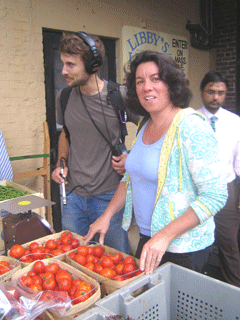
GELLERMAN: Most of us are omnivores. We eat plants and animals. Then, there are vegetarians who eat mostly veggies. And vegans who are stricter and don’t even eat honey or eggs. And then there are “locavores.” That is, people who try to cook and eat food that is grown less than 100 miles from where they live. Today we continue our coverage of eating locally with another audio postcard about community supported agriculture. CSA’s enable people to buy into a weekly share of a local farm’s produce.
Living on Earth’s Ian Gray has a share in Red Fire Farm’s CSA. Food writer Kathy Gunst recently accompanied Ian when he went to pick up his share. The challenge to Kathy: to whip up a dish from what they got. They were there as Jarrett Man, assistant manager of Red Fire Farm CSA, unloaded a truck of fresh produce in Cambridge, MA.
GUNST: So, how many families do you guess you might be feeding this summer?
MAN: We have somewhere in the like 450 member range shares.
GUNST: Wow
GRAY: That’s huge.
MAN: Yeah, most of it goes into Boston. I think 330 every week into Boston. I mean we turned down probably 70 or 80 people from this site.
GUNST: Why would someone in Cambridge care weather their spinach came from your organic farm or they bought it at a co-op or they bought it at a Whole Foods? Why bother with this?
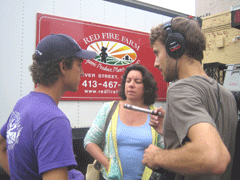
Kathy Gunst and Ian Gray speak with Jarrett Man, assistant manager of Red Fire Farm, in Granby, Massachusetts. (Photo: Amy Fish)
MAN: Well, some people are just in it because it’s the freshest thing you can get. You know some of this stuff we harvested literally this morning. They also are engaging in a community to a certain sense. Their language even is quite telling. They’ll say, “oh this is our farm, this is my farm.” It’s not their farm but they feel like they’re a part of it. I think it’s part of this connection to the land increasingly, you go into this grocery store and everything is wrapped in plastic and who knows where the hell it’s from. And when people don’t feel connected to their food there’s something lost, whether or not they realize it. And so people hungering for this connection can find it through CSAs.
GUNST: Thank you so much that was awesome.
GRAY: Ok, wow. Now we have to gather up all of our grub and then we’re going to go back and cook it.
[MUSIC: Michel Camilo “Just Now” from ‘Spirit of the Moment’ (Telarc International Corp. – 2007)]
GRAY: Ok, so we’re in the kitchen now and we’re going to start pulling stuff out. Do you have an idea of what you’re going to make?
GUNST: I have so many ideas. This is so different from last time where we had greens and we had vegetables that like not A-list stuff, right. We had kale and turnips last time. This is A-list vegetables. We have gorgeous zucchini and yellow squash. We have the first tomatoes of the season. Parsley that is so crunchy and full of flavor. String beans, scallions, cucumbers, but what really got me were these beautiful little beets. They’re the size of not even a baseball, they’re smaller than that.

The first tomatoes of the season! Tomatoes are the signature crop of Red Fire Farm—they grow over 70 varieties on their 50-acre farm in Granby, Massachusetts. (Photo: Amy Fish)
GUNST: Eww! (laughs)
GRAY: Sorry they look like mice from the long root tails there.
GUNST: But they’re so fresh and beautiful. I have this really cool dish called beets Napoleon. So, I’m just going to start by rinsing the beets and then wrapping them in foil and popping them in a hot oven. We’re going to roast them until they’re tender. And then I’m going to slice them and then we’re going to reassemble them with a thin layer of herbed goat cheese in between.
[WATER SOUNDS]
So these beats already have the tops removed so I’m just going to rinse them and you could just put them in a roasting pan, but if you wrap them in some foil it tends to keep the juices in in a really nice way. They’re going to take about 45 minutes to an hour really at about 425 degrees. Ok, we’re just going to pop them in and forget about that. But we’re going to make the goat cheese filling and take a look at the rest of the produce.
Ok, so I’m just using the back of a spoon to soften the goat cheese and it crumbles right up. And you can see it’s a little bit dry when you try to crumble it so we add just about a table spoon or two of milk. And add some pepper and salt to the goat cheese.
[MIXING SOUNDS]
It’s just mixed with a little bit of milk. Alright, so we’ll add about a tablespoon of fresh dill chopped but this could be any herb. You could use basil, you could use thyme, lemon verbena, what ever you have. That’s it. If you wanted to get fancy you could make a really simple green sauce by putting some scallions, and parsley and a little bit of olive oil and maybe a clove of garlic into a food processor and whirl it up, and you’d have a beautiful green sauce to put around your beet Napoleons. So, we have the goat cheese filling done and we’ll just wait for the beets and then we’ll assemble the Napoleons.
All right, let’s check the beets. It’s been, it’s been almost an hour. Look how juicy they are. These are perfect. So, the best way to deal with the beets once they’ve cooled is keep them in the tin foil and put them in your sink. Because, beet juice tends to stain. Like I have beautiful maroon fingers right now but that will come off. So, I’m just trimming of the ends. And I’m using my hands they still are quite hot. You see that? The peel just comes right off.
Ok, and you want to cut each beet into, what is that a quarter of an inch? And this part is really fun. This is the kind of thing you could even do with a kid. It’s almost like decorating a cake you get to layer these beautiful beet slices with this pure white herbed goat cheese. And you can make these two layers or you can tower them up and do three. I’ll look for a little guy on top. And that’s your beet Napoleon. Very arty and fun and you get to play with your food.
GELLERMAN: Kathy Gunst is author of “Stonewall Kitchen Favorites.” You can find the recipe for Kathy’s beet Napoleons and other dishes she whipped up with Ian at loe dot org. Later this fall, Kathy and Ian pick up another box from the Red Fire Farm CSA and we’ll be there to see what she comes up with.
Related links:
- Kathy Gunst’s Website
- Find a Community Supported Agriculture program near you
- USDA definition of Community Supported Agriculture
- LoE’s CSA Pickup #1 from June 22nd
- Click here to see recipes for Beets Napoleon, Zucchini Fritters, and Roasted Ginger String Beans
ANNOUNCER: Support for the environmental health desk at Living on Earth comes from the Cedar Tree Foundation. Support also comes from the Richard and Rhoda Goldman Fund for coverage of population and the environment. This is Living on Earth on P-R-I, Public Radio International.
Emerging Science Note
GELLERMAN: It’s Living on Earth. I’m Bruce Gellerman. Coming up: tea and tradition for two with a British tea master. But first this Note on Emerging Science from Lauren Cox.
[MUSIC: Anonymous “Transformers (Cartoon TV Theme)” from ‘The Transformers’ (1980’s)]
COX: When danger is near, the autobots in this summer’s blockbuster Transformers movie don’t turn to fight-or-flight, they change form. And just like the alien autobots morph when confronted by a foe, so does a species of algae native to earth.
Scientists at the Georgia Institute of Technology have discovered that a common species of ocean algae can dramatically change its shape and size to escape being eaten. The algae, called Phaeocystis, can detect what kind of sea creature is nearby from chemical signals in the water, it can then morph from a tiny single cell into a giant complex colony, or vice versa. The transformation is on the same magnitude as a single mosquito morphing into a dense swarm 70 times bigger than a blue.
By using the transforming trick, algae can increase their chance of survival by a hundred fold, and understanding the algae’s ability to transform might help us survive.
Algae absorb a significant amount of the carbon dioxide in the ocean, and the size the algae takes can determine where the greenhouse gas goes once the algae is eaten… If it’s a large colony it sinks to the ocean floor…if it’s a single cell, it stays near the ocean’s surface where there’s a greater chance it will be released back in the atmosphere.
Obviously, when it comes to algae in the ocean…there’s a lot more than meets the eye. That’s this week’s note on emerging science, I’m Lauren Cox.
[MUSIC: 2.) Mutemath “Transformers Theme” from ‘Transformers: The Movie’ (Warner Bros. – 2007)]
Trading Salt Ponds for Salt Marshes
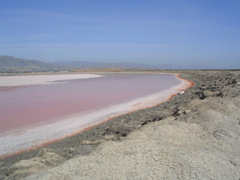
A high salinity pond at low tide. The pond is so salty that it actually has a layer of gypsum on it’s surface.(Photo: Andrea Kissack)
GELLERMAN: One of the biggest and most ambitious environmental restoration projects in the country is now underway in San Francisco Bay. It will take decades and upwards of a billion dollars to turn thousands of acres of industrial salt ponds back into wetlands. As Andrea Kissack reports from San Francisco, the work is helping nature make a comeback.
KISSACK: If you’ve ever flown into San Francisco International Airport then you've seen the salt ponds. A checkerboard of orange, red and yellow hues formed by algae from high salinity levels. Go a little closer still and some of the salt ponds look like the surface of the moon: sinuous water channels flow through a layer of chalky white crust. Back in the 1800’s this former tidal marsh was diked off by levees to create ponds for salt making. In fact in some parts of the Bay, they’re still making salt, for food, medicine and road de-icing.
MOPELLI: This is our reclaim area here. This is where the salt after it’s harvested it’s been washed and it has been stacked.
KISSACK: This East Bay salt plant is owned and operated by Cargill, the Minnesota-based multinational food firm. Pat Mopelli stands dwarfed by an 80-foot high stack of salt that looks like the white top of a circus tent.
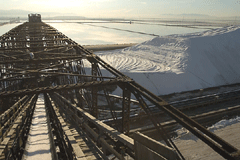
Cargill salt beds. (Courtesy of Cargill)
KISSACK: We crunch our way over a salt covered road until we reach the edge of the bay. In front of us is a surreal site, what looks like a frozen alpine lake just beginning to melt. These are Cargill’s crystallizer beds --the heart of the company’s evaporative salt making operation.
MOPELLI: You actually start to see almost what looks like ice or glassy look on the surface. As those crystals continue to grow, and they do grow, they become heavy and drop to the bottom of the crystallizer bed. And so what we are looking at is this nice even flat surface for us to be able to harvest on.
KISSACK: The water in these engineered shallow beds is going through the final stages of evaporation. The process ends here, but it actually begins out in the ponds that ring the bay.
MOPELLI: If you follow a salt molecule from the time it is pumped in from the bay through the concentration process, until it actually is precipitated out on the crystallizer, it takes on the average about four to five years.
KISSACK: Cargill sold the majority of its ponds, in 2003, to the state and federal government for 100-million dollars. Now a coalition of groups is overseeing an effort to turn 16,000 acres of former salt ponds - an area the size of Manhattan - back to natural wetlands. It’s a gargantuan effort to roll back the clock 150 years.
[AMPHIBIOUS DUMP TRUCK]
KISSACK: At the southern edge of the bay, in the Alviso Slough, near San Jose, amphibious dump trucks working on the restoration dig out mud that keeps sliding back into a channel.
MRUZ: Yeah, I can’t wait for this channel to be excavated. Basically this system has been our problem child.
KISSACK: Eric Mruz is a biologist managing the ponds for the U.S. Fish and Wildlife Service. He has been dogged by this one channel that is supposed to allow the tide to flush out a salt pond here.
MRUZ: All our water quality requirements have just been horrible for this pond. It’s because we can’t funnel enough fresh water through the system.

Cargill salt stack. Represents about a year's harvest from the crystallizer beds in the foreground. (Courtesy of Cargill)
RITCHIE: Sediment has moved into those much more than we expected. So what we are seeing out there right now are really extensive mud flats that are very rich and great feeding opportunities for a lot of shore birds. We are seeing fish come back through the channels so that fish eating birds are having a great time out there. So we really seem to see some pretty active restoration going on just now it’s just been a year since we’ve breached them.
[SEAGULL CALLS]
KISSACK: Standing on a bluff just south of the San Francisco airport, Ritchie points northwest toward Eden Landing, where another levee should be breached this fall. But with such encouraging early results, why wait so long? Ritchie says we can’t just turn it all back.
RITCHIE: We humans have changed the landscape so much that it would be irresponsible to instantly try to put it back the way it was. We would be extremely surprised and potentially have some really bad consequences we don’t want out there.
KISSACK: Like flooding. When the ponds were created the population in the Bay Area was only a few hundred thousand - far below the seven million it is now. Today, many people live or work right against the edges of the bay. In 40 years, says Ritchie, a combination of factors such as rising sea levels from climate change and a bad storm could mean disastrous flooding for Silicon Valley.
RITCHIE: Actually, what you have right behind the ponds, is you have obviously a couple of major freeways, you have the three sewage treatment plants that serve northern Santa Clara County and you have major silicon valley businesses Google, Yahoo, etc., etc. there is just many right there.

A high salinity pond at low tide. The pond is so salty that it actually has a layer of gypsum on it’s surface. (Photo: Andrea Kissack)
And then there is another challenge that has Ritchie, and others, playing Mother Nature, as they determine just which habitat will survive. It turns out, some species actually thrive on salt ponds but others don’t.
RITCHIE: California clapper rail, and salt marsh harvest mouse were the species that really utilized that area and they’ve become endangered because of the reduction in it when they were converted to salt ponds a whole lot of other species moved in, so one of the that things we have to do in terms of habitat is strike a balance between those species. We want to recover the tidal marsh area and the tidal marsh species but we don’t want to do it solely at the expense of species that like ponds.
KISSACK: If concerns such as flooding or choosing which species will survive isn’t daunting enough, how about raising a billion dollars? That’s how much restoring the more than 20 miles of shoreline could cost to complete. The task of bringing back the edges of San Francisco Bay may seem formidable but the fact that it is even possible makes many people want to try. For Living on Earth, I’m Andrea Kissack.
[MUSIC: Daniel Lanois "O Marie" from 'Arcadie' (Daniellanois.com - 2005)]
Related links:
- Cargill Salt
- San Francisco Save the Bay
Home Ground: Painted Hill
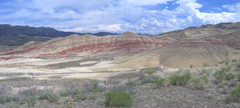
The Painted Hills of Oregon. (Photo: Mark Schindler)
GELLERMAN: Picture a landscape of a place you love. The image is more than the sum of its parts. There’s an intimacy, a special relationship we have with the land and the forms that are special to us, even as they change. To know a place, to truly know a place is a way of making it our own. Writers Barry Lopez and Debra Gwartney asked 45 authors to describe features of landscapes. The definitions are part of a collection called “Home Ground - Language for an American Landscape.” We’ve asked several writers to read from their entries. Today, John Daniel of Oregon has his definition of “painted hill.”
DANIEL: Painted hill. Badlands produce colorful heaps and mounds called painted hills in central Oregon. Striped horizontally in soft interbled hues of red green and pale gold with punctuations of black manganese. The Oregon painted hills embody volcanic ash worked by plants, animals and groundwater into ancient soils now compacted into clay stone layers.

The Painted Hills of Oregon.(Photo: Mark Schindler)
At present, a region of semi arid steppe this geological library of antiquated earth. In the phrase of geologist Ellen Morris Bishop records more than 30 million years of climatic and biotic regimes ranging from subtropical swamp through temperate oaks of annum.
Except for brief skullcaps of bunch grass little vegetation can root in the dense weathered clay of the painted hills. Their life is in their colors which can shift subtly before one’s eyes as the clay takes on the moisture of rain and lets it go. The painted desert of Arizona contains similar formations, called pintaras by early Spanish Americans and by the Navajo land of the sleeping rainbow.
[MUSIC: Laura Veirs “Wrecking” from ‘Saltbreakers’ (Nonesuch Records – 2007)]
GELLERMAN: John Daniel lives and writes in the hills just outside of Eugene, Oregon. His definition of “painted hill” is included in the book, “Home Ground - Language for an American Landscape,” edited by Barry Lopez and Debra Gwartney. We’ll bring you more places from “Home Ground” in the weeks ahead.
Related link:
Home Ground Project
Tea-ing off with a Master
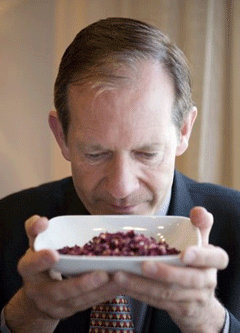
Tea Master Giles Hilton sniffing a floral rosehip and Earl Grey blend. (Photo: Dennis Foley)
GELLERMAN: Mmmmm. There’s nothing quite like a crisp cup of freshly brewed iced tea to take the heat off a hot summer day.
[SLUUUURP]
GELLERMAN: Yup tea is time –tested. Legend has it that in 2737 BC Chinese Emperor, Shen Nung, discovered brewing tea quite by accident, when, sitting in his garden one morning, a single leaf fell into his bowl of hot water. Intrigued by the fragrant aroma he brewed a cup and the rest is ancient history. Today, tea is hot. It’s used in everything from shampoos to face creams. And health conscience consumers increasingly reach for cups of tea rich in antioxidants. Giles Hilton knows a lot about tea. He’s Master Tea Blender at Whittard of Chelsea, proprietors of tea and a London institution since 1866. Mr. Hilton was in Boston recently for the grand opening of Whittard’s first 'across the pond' tea blending store. There he talked about the little leaf that’s steeped in so much tradition.
[MUSIC: Jim Gibson "Tea For Two" from ‘The Art of Tea’ (Hickory Cove Music - 1997)]
HILTON: I think that the rest of the world thinks that we English simply live on tea. If in doubt we make a cup of tea. First thing in the morning, a cup of tea. A moment of crisis, a cup of tea. Relaxation before going to bed, a cup of tea. It is definitely in the English culture.
MAN SINGING: Every nation in creation has its favorite drink. France is famous for it’s wine. It’s beer in Germany. Russia goes for vodka. England loves its tea.
[From, Long John Baldry “Everything Stops for Tea” from ‘Everything Stops for Tea’ (Warner Bros. – 1972)
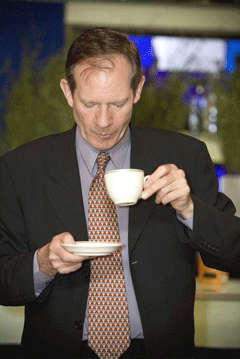
Giles Hilton sipping his cuppa.(Photo: Dennis Foley)
HILTON: So, the early English traders in their sailing boats found China. So the English took Hong Kong Island as their settlements because the Chinese wouldn’t let them into mainland China. They traded for anything they could get, be it silk, or jewels or tea. The English were trading back into England from the Far East with tea so we hit the tea culture first. Tea is well known for containing antioxidants. These antioxidants are, they are natural ingredients in the tealeaf. And it is particularly good for the health. And the body can absorb these antioxidants and polyphenols. These antioxidants seem to have an ability, if you like, to almost purify the body a bit. Certainly tea is a very good digestive. It will help the body not absorb too much fat from fatty foods. And help build up that sort of immune system to minor complaints and diseases.
When you think of a tea there are endless choices. It’s almost like self-analysis isn’t it? In other words come on what do I enjoy in life? Do I want red wine or white wine? We see you are able to make that a choice. Do I want a strong tea, a light tea, an herbal tea because I’m thinking of my health?
MAN 1: I’d like a pot of tea please.
MAN 2: Earl Gray or Lapsang Souchong?
MAN 1: No, tea.
[From, Bob Hoskins “Mona Lisa (Film Clip Quote)” from ‘Mona Lisa’ (Starz/Anchor Bay – 1986)]
HILTON: It’s an interesting question when people say, what is leading the interest in teas. What is increasing sales in certain areas? The pop culture so to speak, what is on television, what someone drinks definitely has an effect because the word of that tea is suddenly in the public mind.
MOVIE: Tea, Earl Gray, hot. [From, Patrick Stewart “Earl Grey Hot (TV Clip Quote) from “Star Trek: The Next Generation” (Paramount – 1987)]
HILTON: And so Earl Gray is one of our best sellers, without a doubt. There are two aspects I suppose to really enjoying tea. One is in the mind, one is in the pallet if you like. So, I will prepare a cup of tea with out great pretension. I don’t have to have great China. I don’t have to have a beautiful teapot. I just make tea.

Tea Master Giles Hilton sniffing a floral rosehip and Earl Grey blend. (Photo: Dennis Foley)
MOVIE: The serving of tea to friends is an old and very enjoyable custom and so it has its traditions. [From, Anonymous “Arranging The Tea Table (Flm Clip Narration)” from ‘Arranging the Tea Table’ (1950)]
HILTON: Sometimes with a pinch of leaves picked up with my fingers and dropped into a cup. So, the pleasure is in that flexibility of making tea. Start with fresh drawn cold water. Bring it to a boil. However you boil it, it doesn’t matter.
[TEA POT WHISTLE]
HILTON: But try to give a tea two, three, four minutes to brew to get the flavor out. Leaving the tea in longer over brews it and after about five minutes you almost develop a bit of harshness or woodiness because you’ve soaked the best essential oils from the tealeaves. And then pour it almost still bubbling onto your tea bag or onto the leaves. And the reason it’s bubbling is that it’s full of oxygen, full of life, full of brightness. And it has a great effect on the tea. It brings it back to life, it brings out the flavor efficiently. And then don’t waste the leaves just top off the kettle again with boiling water or just very hot water, pour it into your brewed leaves and have a second cup 10 minutes later. No problem at all. You should be being more economical, use less and get two or three brews out of it.
Tea is probably one of the most natural products in the world. If you actually analyze it you have picked leaves, rolled them in a large flat roller, broken them up, applied warm air to dry them, and that’s it. You’ve added no preservatives, no flavor additives. Nothing what so ever has been added to that at all.
[SIPPING SOUNDS]
MAN: That is actually super.
HILTON: (laughs) And off you go.
[MUSIC: Art Tatum “Tea For Two” from ‘Tea for Two’ (1201 Music – 1945)]
GELLERMAN: Giles Hilton is Master Tea Blender at Whittard of Chelsea. The British company recently opened its first tea shop in America in the city that’s the site of the Boston Tea Party. Living on Earth’s Dennis Foley produced our audio profile. To learn more about the art of tea making, visit our website loe.org.
Related link:
Whittard of Chelsea
GELLERMAN: On the next Living on Earth: you’ve heard of a bull in a china shop what about a buffalo in your house?
[PRAIRIE AND BISON SOUNDS]
GELLERMAN: We leave you this week, home, home on the range.
[SOUND: “Prairie Winds” recorded by Bernie Krause & Lang Elliott for ‘Wild Sanctuary’ (Four Winds Trading Company – 2002)]
GELLERMAN: Where seldom is heard a discouraging word of the bison and coyotes. They make their playground where the skies are not cloudy on the vast, windswept grasses of the American and Canadian plains. Lang Elliott and Bernie Krause recorded these prairie home companions for the wild sanctuary dot com audio series.
[COYOTE HOWLS]
GELLERMAN: Living on Earth is produced by the World Media Foundation. Our crew includes Ashley Ahearn, Eileen Bolinsky, Ian Gray, Ingrid Lobet, Andrea Smardon, and Jeff Young - with help from Bobby Bascomb, Jeff Turton and Kelley Cronin. Our interns are Lauren Cox and Amy Fish.
Alison Lirish Dean composed our themes. Today, we bid happy trails to our technical director, Dennis Foley, as he heads off into the sunset and the Lone Star state. Dennis brought a rare combination of talents in journalism, engineering and music to our show and we are going to miss him. I’m Bruce Gellerman. You can find us at LOE dot org.
Thanks for listening. Y’all come back for a visit, ya hear?
ANNOUNCER: Funding for Living on Earth comes from the National Science Foundation, supporting coverage of emerging science. And, Stonyfield Farm Organic yogurt and smoothies. Stonyfield pays its farmers not to use artificial growth hormones on their cows. Details at Stonyfield dot com.
Support also comes from you our listeners, the Ford Foundation, the Wellborn Ecology Fund and Pax World Mutual Funds; socially and environmentally sustainable investing. Pax World, for tomorrow. On the Web at paxworld dot com.
Living on Earth wants to hear from you!
Living on Earth
62 Calef Highway, Suite 212
Lee, NH 03861
Telephone: 617-287-4121
E-mail: comments@loe.org
Newsletter [Click here]
Donate to Living on Earth!
Living on Earth is an independent media program and relies entirely on contributions from listeners and institutions supporting public service. Please donate now to preserve an independent environmental voice.
NewsletterLiving on Earth offers a weekly delivery of the show's rundown to your mailbox. Sign up for our newsletter today!
 Sailors For The Sea: Be the change you want to sea.
Sailors For The Sea: Be the change you want to sea.
 Creating positive outcomes for future generations.
Creating positive outcomes for future generations.
 Innovating to make the world a better, more sustainable place to live. Listen to the race to 9 billion
Innovating to make the world a better, more sustainable place to live. Listen to the race to 9 billion
 The Grantham Foundation for the Protection of the Environment: Committed to protecting and improving the health of the global environment.
The Grantham Foundation for the Protection of the Environment: Committed to protecting and improving the health of the global environment.
 Contribute to Living on Earth and receive, as our gift to you, an archival print of one of Mark Seth Lender's extraordinary wildlife photographs. Follow the link to see Mark's current collection of photographs.
Contribute to Living on Earth and receive, as our gift to you, an archival print of one of Mark Seth Lender's extraordinary wildlife photographs. Follow the link to see Mark's current collection of photographs.
 Buy a signed copy of Mark Seth Lender's book Smeagull the Seagull & support Living on Earth
Buy a signed copy of Mark Seth Lender's book Smeagull the Seagull & support Living on Earth

